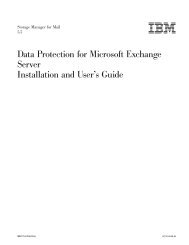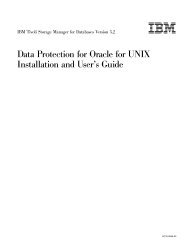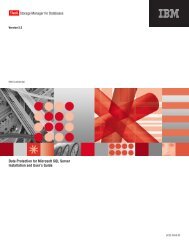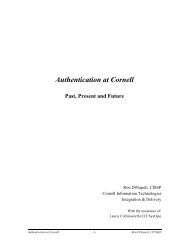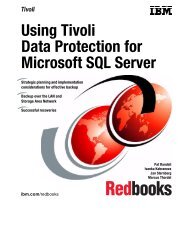Backing Up Oracle - Computing at Cornell
Backing Up Oracle - Computing at Cornell
Backing Up Oracle - Computing at Cornell
Create successful ePaper yourself
Turn your PDF publications into a flip-book with our unique Google optimized e-Paper software.
As part of the duplic<strong>at</strong>ion oper<strong>at</strong>ion, RMAN manages the following:<br />
Restores the target d<strong>at</strong>afiles into the duplic<strong>at</strong>e d<strong>at</strong>abase and performs<br />
incomplete recovery using all available archived redo logs and<br />
incremental backups.<br />
Opens the duplic<strong>at</strong>e d<strong>at</strong>abase with the RESETLOGS option after incomplete<br />
recovery to cre<strong>at</strong>e the online redo logs.<br />
Gener<strong>at</strong>es a new, unique d<strong>at</strong>abase identifier for the duplic<strong>at</strong>e d<strong>at</strong>abase.<br />
When duplic<strong>at</strong>ing a d<strong>at</strong>abase, you can do the following:<br />
Skip read-only tablespaces with the skip readonly clause. Read-only<br />
tablespaces are included by default. If you omit them, you can add them<br />
l<strong>at</strong>er.<br />
Cre<strong>at</strong>e your duplic<strong>at</strong>e d<strong>at</strong>abase in a new host. If the directory structure is<br />
the same on the new host, you can use the nofilenamecheck option and<br />
reuse the target d<strong>at</strong>afile filenames for the duplic<strong>at</strong>e d<strong>at</strong>afiles.<br />
Use the set until option when cre<strong>at</strong>ing the duplic<strong>at</strong>e d<strong>at</strong>abase to recover<br />
it to a non-current time. By default, the duplic<strong>at</strong>e command cre<strong>at</strong>es the<br />
d<strong>at</strong>abase using the most recent backups of the target d<strong>at</strong>abase and then<br />
performs recovery to the most recent consistent point contained in the<br />
incremental backups and archived redo logs.<br />
Use the duplic<strong>at</strong>e command without a recovery c<strong>at</strong>alog.<br />
Register the duplic<strong>at</strong>e d<strong>at</strong>abase in the same recovery c<strong>at</strong>alog as the target<br />
d<strong>at</strong>abase. This option is possible because the duplic<strong>at</strong>e d<strong>at</strong>abase receives<br />
a new d<strong>at</strong>abase identifier during duplic<strong>at</strong>ion. If you copy the target<br />
d<strong>at</strong>abase using oper<strong>at</strong>ing system utilities, the d<strong>at</strong>abase identifier of the<br />
copied d<strong>at</strong>abase remains the same so you cannot register it in the same<br />
recovery c<strong>at</strong>alog.<br />
In our test environment, we duplic<strong>at</strong>ed the d<strong>at</strong>abase oslo to the d<strong>at</strong>abase<br />
berlin. Both d<strong>at</strong>abases are loc<strong>at</strong>ed on the same AIX system.<br />
We performed the following steps:<br />
We cre<strong>at</strong>ed an <strong>Oracle</strong> password file for the new instance berlin:<br />
cd $ORACLE_HOME/dbs<br />
orapwd file=orapwberlin password=change_on_install entries=10<br />
Chapter 8. Recovering <strong>Oracle</strong> D<strong>at</strong>abases on UNIX 115




